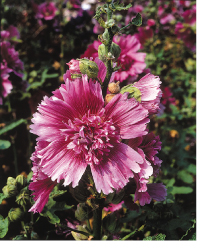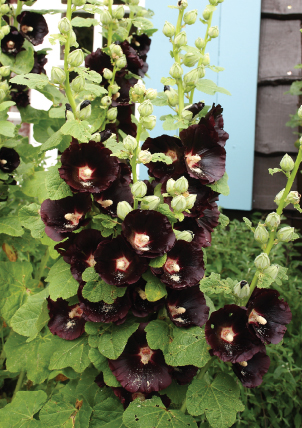If your grandmother enjoyed gardening, chances are pretty good she grew hollyhocks, Alcea rosea. An old-fashioned favorite, hollyhocks can be striking, colorful additions to any garden.
So, why aren’t they seen in more gardens these days?
It’s probably because a lot of pests and diseases love hollyhocks. Leaf miners, weevils, Japanese beetles, spider mites, sawflies, slugs and other pests stand in line for a chance at these plants, while rust and powdery mildew are constant threats.
And then there is the fact that many hollyhocks are grown as biennials, a weird plant-growing state that not all gardeners understand. A biennial is a plant that is started from seed one year and matures the next year.
 So why grow hollyhocks at all? Well, because they are so darn pretty, and since their bloom spikes can reach upward of 8 feet, they can make quite a statement in the landscape. Many bad bugs can be held in check by periodic insecticidal soap sprays, while rust-resistant varieties and fungicides are available. And if the hollyhocks do become overwhelmed with problems, it is usually after their cheerful flower show is on the wane, so the cure is to simply cut down the plants and toss them away.
So why grow hollyhocks at all? Well, because they are so darn pretty, and since their bloom spikes can reach upward of 8 feet, they can make quite a statement in the landscape. Many bad bugs can be held in check by periodic insecticidal soap sprays, while rust-resistant varieties and fungicides are available. And if the hollyhocks do become overwhelmed with problems, it is usually after their cheerful flower show is on the wane, so the cure is to simply cut down the plants and toss them away.
Hollyhock plants can be found at nurseries in the spring, but a better way to grow these beauties is from seed. Why? One word: variety. There are more than 60 species of hollyhocks and many, many cultivars to choose from, but most can only be bought as seed. So, for the largest selection, sowing seeds is the way to go.
Need examples of handsome hollyhocks? Start with the mysterious black hollyhock, Alcea rosea nigra, actually an old heirloom plant that was enjoyed in colonial gardens, including Thomas Jefferson’s Monticello. Prefer brighter blooms? ‘Polarstar’ will shine with its beautiful white flowers — a look echoed by the pale blooms of ‘Halo White’. ‘Mars Magic’ can cast a brilliant red spell over the garden, and while ‘Halo Red’ shows off a similar crimson color, its blossoms are accented with pleasing yellow centers.
Single blooms have been the classic hollyhock look for ages, but now many new, sassy cultivars flaunt dazzling double flowers, such as ‘Queeny Purple’, an All-America Selections winner short in stature (only 2 to 3 feet tall) but long on loads of fluffy, colorful blooms. Not to be outdone, the 6-foot-tall ‘Peaches ’n’ Dreams’ is as advertised — extended spikes loaded with peach-colored powder-puffs. And ‘Chathers Maroon’ will enchant any garden with its ruby-red double blossoms.
Can’t decide which hollyhock hue is for you? Many hollyhocks are also offered as mixes in different colors. If you are unable to find the seeds of a mix or a particular cultivar at your local garden center, Burpee (burpee.com) and Park Seed (parkseed.com) are good e-places to start a search online.
Grown as biennials, hollyhocks are best seeded in our area in the waning summer, which means late August is prime planting time. Plant seeds in a sunny location in soil that is well-worked and heavily amended with organic material. The seeds only need to be set about a quarter-inch below the soil surface, but they should be spaced about 18 inches apart. Small rosettes will soon form, and, yes, these miniature mounds of foliage are hardy enough to overwinter in the garden.
Come spring, the plants will rapidly grow, and this growth should be encouraged by applications of liquid fertilizer every two to three weeks. The beautiful flower spikes will then begin their glorious show in late spring or early summer, and when these blooms are at their best, then you’ll know why Granny always saved room for hollyhocks in her garden.
L.A. Jackson is the former editor of Carolina Gardener magazine.







